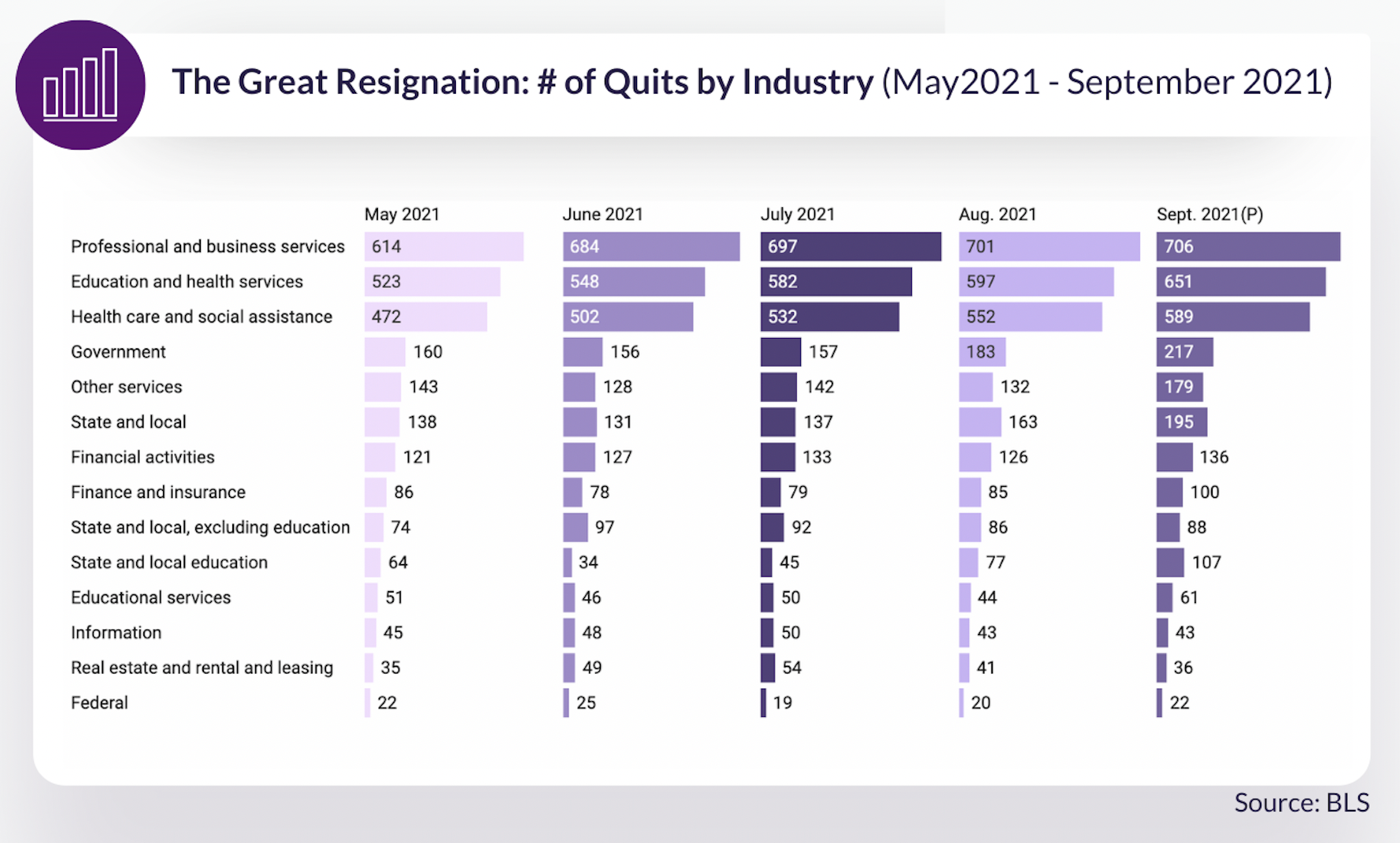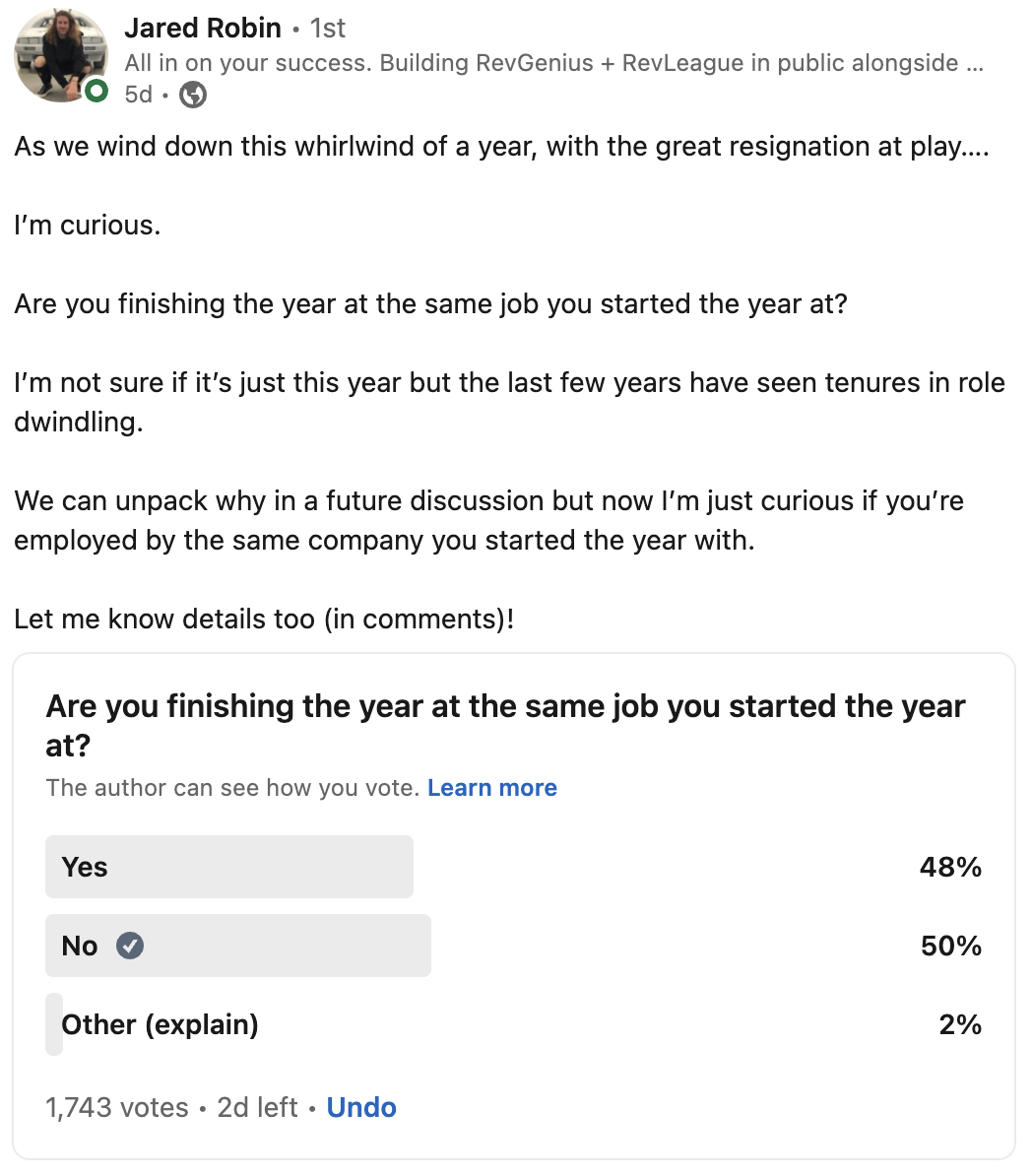We previously explored the impact of the Great Resignation on the health care industry. Most industries have only seen a marginal impact, especially compared to those that heavily employ hourly wage workers, such as retail, restaurants, and hospitality. However, three industries have managed to buck that trend by producing high quit rates as hundreds of thousands of workers quit each month.
Throughout 2021, the professional and business services industry consistently experienced the worst turnover rate for office-centric industries. That trend appears to have no signs of slowing as we head into 2022.
Survive 2024 with Upskilling
Download a free copy of our Workforce Survival Guide!
Over 3.4 Million Office Workers Quit Professional Service Jobs Within 5 Months
The Bureau of Labor Statistics (BLS) provides regular updates on key labor market statistics, including the number of workers voluntarily quitting jobs (versus layoffs or furloughs), and the overall quit rate for each industry. Its data dumps for 2021 have shown a complete reversal in the labor market compared to the start of the pandemic.
2020 will be remembered for the large number of workers losing jobs due to the impact of the global pandemic and lockdowns. The unemployment rate spiked, especially in hospitality and leisure, where the rate hit nearly 40% in April 2020. Meanwhile, 2021 has already broken historic records of its own as one of the most intense labor shortages in US history, and what some are comparing to the Peasants’ Revolt of 1831.
The professional service industry quit rate is 100% higher than its 20-year low and 52% higher than its 2020 low
Most of the labor crunch is centered around hourly-wage jobs, but the Great Resignation is knocking at the door for many “white collar” employers, as well. Recent BLS data reveals the professional and business services industry saw 3.4 million workers quitting between May and September of 2021.

To put these numbers into perspective:
- 20 million Americans quit their jobs between May and September of 2021
- 17% of those quits were in the professional and business services industry
- The hard-hit hospitality and leisure industry represented just 21% of those quits

The total number of workers quitting the professional and business services industry rose by over 14% between May and September of 2021. The outlook gets worse when you pan out to a 20-year view. The quit rate for the industry hit a 20-year high in April 2017 of 3.7 and was averaging around 3.2 between May and September of 2021.
Based on historic data for the industry, that means the quit rate for the professional and business services industry is now 52% higher than its 2020 low, and 100% higher than its 20-year low set in 2009.
These numbers are frightening news for employers in any industry. Gallup notes that the cost to replace an employee can range from one-half to double that employee’s salary. Across all industries, that results in around $1 trillion in turnover costs, including both the direct replacement costs (posting and advertising the job, onboarding, training, etc.), and the indirect costs (lost revenue that the employee may have been producing for the company).
Where Are Professional and Business Service Workers Going?
Workers in the professional services industry, by and large, are not quitting for good. Instead, they’re taking advantage of the extensive labor shortage within this industry. These workers are leaving their current employers for companies providing a better work experience.
- There were 1.8 million job openings within this industry in September 2021, but only 1.2 million hires. That’s a gap of 600,000 jobs.
- There were 1.1 million separations in this industry, which is close to the total number of hires. This is an indication of a high amount of worker movement between employers.
On LinkedIn, a poll posted by RevGenius Co-Founder Jared Robin asked a simple question: “Are you finishing the year at the same job you started the year at?” Of the 1,700+ respondents (at this time of writing), 50% said “no”.

Notably, this poll’s results align well with a Harris Poll released in October 2021 that discovered 50% of American workers want to make a career change. Taken together, the data is clear. Workers across industries, and especially in professional and business services, aren’t just thinking about quitting. They’re following through. That’s an exceptionally troubling sign for employers and speaks to a retention problem for organizations that aren’t giving workers what they want or need to survive within a transformed work environment.
What’s Behind the Worker Revolt in Professional and Business Services?
The problems facing the professional and business services industry are unique. Whereas hospitality and leisure workers are primarily focused on better pay, office worker salaries have largely been increasing along with inflation. Instead, office workers experienced “pandemic epiphanies” that caused them to re-evaluate the entire meaning of work.
People now want:
- A continuation of remote work, including fully remote and hybrid work schedules
- More skills development, including upskilling and reskilling opportunities
- Visibile career pathing on day one
- Stronger connections and opportunities to connect with their coworkers, especially within remote work environments Authentic connections with their coworkers
- Diverse and inclusive work environments
This industry consists of hundreds of thousands of businesses that provide their technical expertise to other organizations. The industry includes legal services, advertising firms, accounting firms, architecture companies, management consulting, and more.
A common feature of employers in this industry is a high degree of technical skill and knowledge among its workforce, and the ability to work remotely. It comes as no surprise, then, that hesitancy to go back to the office full time and a stronger desire for personal and professional growth are key among the reasons these workers are quitting in large numbers.
Businesses that hope to withstand the ongoing Great Resignation will need to find a way to provide these benefits to existing and future team members.
IBM subsidiary Red Hat, Inc. provides a variety of software-based solutions to enterprise organizations, including applications, management products, middleware, and other open-source software products. The company has offered mentoring programs for years, but in 2018, decided to leverage mentoring software to create a streamlined and efficient matching and program management process.
The benefit of its strategy was quick. The company experienced a 63% decrease in employee turnover among program participants and $6 million in retention savings. Its mentoring program sees a 96% retention rate for participants. Mentoring has served the strong desire among Red Hat’s workers for career pathing and career development.
- Around 40% of its program participants had some type of intra-company job movement
- 60% of those intra-company movements were promotions
- The promotion rate for participants was 2x that of the non-participants within the company
The company now provides a dozen different mentoring programs that meet a variety of worker needs. Its Career Track mentoring program is particularly popular, with thousands of participants eager to take advantage of the one-to-one relationships that lead to career pathing visibility and much-desired skills development.
Reducing Turnover Is an Imperative for Professional and Business Services Companies
Data from the Bureau of Labor Statistics reveals some industries are safe from the Great Resignation. Unfortunately, the professional and business services industry is not one of them. People spent the pandemic working from home under adverse conditions. As the pandemic wanes, many are examining their future work environments with their current employers. Many are coming to the conclusion that they don’t like what they see. The labor market is weighted toward their needs and not employer wants. Employers need to cater to those needs or risk hurting under increasing employee turnover.
Companies like Red Hat have found that mentoring software is an effective solution to reduce turnover. While Red Hat’s mentoring programs were in place before the pandemic, allowing it to avoid the worst impacts from the Great Resignation, there’s still time for other companies in this industry. Organizations can start implementing retention strategies such as mentoring today to become more competitive in the current job market.





